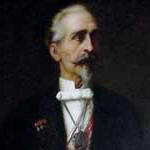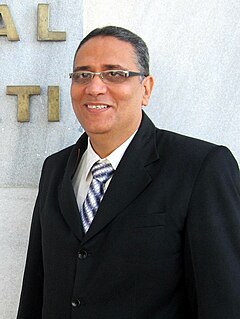A national academy is an organizational body, usually operating with state financial support and approval, that co-ordinates scholarly research activities and standards for academic disciplines, most frequently in the sciences but also the humanities. Typically the country's learned societies in individual disciplines will liaise with or be co-ordinated by the national academy. National academies play an important organisational role in academic exchanges and collaborations between countries.

An academy of sciences is a type of learned society or academy dedicated to sciences that may or may not be state funded. Some state funded academies are tuned into national or royal as a form of honor.

Carlos Juan Finlay was a Cuban epidemiologist recognized as a pioneer in the research of yellow fever, determining that it was transmitted through mosquitoes Aedes aegypti.

The Mexican Academy of Sciences(Academia Mexicana de Ciencias) is a non-profit organization comprising over 1800 distinguished Mexican scientists, attached to various institutions in the country, as well as a number of eminent foreign colleagues, including various Nobel Prize winners. The organization, which encompasses exact and natural sciences as well as the social sciences and humanities, is founded on the belief that education, based on the truth of scientific knowledge, is the only means, in the short and long term, of achieving the development of the Mexican spirit and national sovereignty.

The Spanish National Research Council is the largest public institution dedicated to research in Spain and the third largest in Europe. Its main objective is to develop and promote research that will help bring about scientific and technological progress, and it is prepared to collaborate with Spanish and foreign entities in order to achieve this aim.
Enrique Caravia Montenegro was a Cuban artist.

The Lisbon Academy of Sciences is Portugal's national academy dedicated to the advancement of sciences and learning, with the goal of promoting academic progress and prosperity in Portugal. It is one of Portugal's most prestigious scientific authorities and the official regulator of the Portuguese language in Portugal, through its Class of Letters.

Francisco de Albear y Fernández de Lara was a Spanish engineer from Cuba.

The Spanish Royal Academy of Sciences is an academic institution and learned society that was founded in Madrid in 1847. It is dedicated to the study and research of mathematics, physics, chemistry, biology, engineering, and related sciences.

Margarita Salas Falgueras, 1st Marchioness of Canero was a Spanish scientist, medical researcher, and author in the fields of biochemistry and molecular genetics.

The University of Havana or is a university located in the Vedado district of Havana, the capital of the Republic of Cuba. Founded on January 5, 1728, the university is the oldest in Cuba, and one of the first to be founded in the Americas. Originally a religious institution, today the University of Havana has 15 faculties (colleges) at its Havana campus and distance learning centers throughout Cuba.

Pedro Antonio Valdes-Sosa, is the General Vice-Director for Research of the Cuban Neurosciences Center, which he cofounded in 1990. He is also Member of the Editorial Boards of the following journals: Neuroimage, Medicc, Audiology and Neurotology, PLosOne Frontiers, Neuroimage and Brain Connectivity. His work includes statistical analysis of electrophysiological measurements, neuroimaging, nonlinear dynamical modeling of brain functions and Software and electrophysiological equipment development.

Miguel Angel Fernández Sanjuán is a Spanish Theoretical Physicist from Leon, Spain. He is known for his contributions in nonlinear dynamics, chaos theory, and control of chaos, and has published several scientific papers and popular news articles. He has supervised around 20 PhD students in Nonlinear Dynamics, Chaos and Complex Systems.

Javier Perez-Capdevila is a Cuban scientist, mathematician and professor, known for the introduction of the operation mixed mixtures of fuzzy sets, among other theoretical contributions to fuzzy mathematics, as well as to introduce a concept of labor competencies with a method to measure them.

The Sociedad Económica de los Amigos del País de la Habana or Real Sociedad Patriótica de la Habana is a learned society in Havana, Cuba. It was initially organized to promote agriculture, commerce, education, and industry, modelled on the Sociedad Económica de los Amigos del País in Spain. Founding members included Diego de la Barrera, Francisco Joseph Basabe, José Agustín Caballero, Luis de Las Casas, Juan Manuel O'Farrill, Tomás Romay y Luis Peñalver, and Antonio Robledo. In its early decades the group produced publications, maintained a library in the Convento de Santo Domingo (1800-1844), and arranged educational programs. Around the 1790s the group built the Hospicio o Casa de Beneficencia in Havana.
The Museo Nacional de Historia Natural Cubana or Museo Nacional de Historia Natural de Cuba in Havana, Cuba is the national museum of Natural History, with exhibits of Cuba's plants and animals. It is located in a former U.S. embassy building.

The Academia Nacional de Ciencias is Costa Rica's Academy of Sciences. It was created as a “permanent forum for discussion and scientific analysis,” and serves both as an honorific society and a source of scientific advice for the government. Its mandate is to promote scientific culture and progress within Costa Rica, and collaboration between national and international agencies. It maintains membership in international organizations such as the International Council for Science (ICSU), the InterAmerican Network of Academies of Sciences (IANAS) and the Third World Network (TWN). Its headquarters are in San Pedro in the province of San José.

The Ministry of Science, Technology and Environment of the Republic of Cuba, also known as CITMA, is the Cuban government ministry which oversees state politics in matters of science, technology, environment and the usage of nuclear energy. Its headquarter is in a building of Calle Línea, a street of central Havana next to the Malecón, and part of Vedado, a ward of the municipal borough of Plaza de la Revolución.
The Spanish Royal Physics Society (RSEF) is a non-profit institution for the branch of Physical Sciences resulting from the division in 1980 of the Spanish Royal Society of Physics and Chemistry, founded in 1903, into the Royal Societies of Physics and Chemistry (RSEQ) of today. The RSEF has been officially recognised as an Association of Public Interest. It aims to promote and develop the basic knowledge of physics and its applications, and to encourage scientific research and teaching of physics in all reaches of education. The RSEF operates on a national scale and maintains international relations with other Societies with similar aims, including Iberoamerican Societies. More details and the Statutes of the RSEF can be found on its website, http://rsef.es/
Máximo Gómez Command Academy is a military institution of the Cuban Revolutionary Armed Forces. The academy, which is located to the east of Havana, is the principal senior service school for the training of soldiers in the FAR. It currently bears the name of Major General Máximo Gómez, who was a 19th century Cuban independence fighter. It was founded in 1963 and is under the orbit of the Ministry of the Revolutionary Armed Forces (MINFAR), whose employees are trained by the school. The command academy has been decorated with many military and state awards such as the Order of Antonio Maceo and the Order of Carlos J. Finlay.














